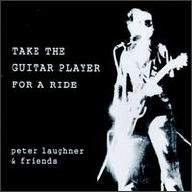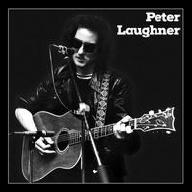Peter Ravenscroft Laughner was born on August 22, 1952. He spent most of his childhood in the Cleveland suburb of Bay Village, and became interested in music at an early age. When he was in junior high, Laughner and his friends formed a band, the Fifth Edition, who played school dances and appeared at teen centers. In 1968, Laughner landed a part-time job at a record store, where he was able to indulge his growing appetite for different sorts of music; by this time, the Fifth Edition had evolved into a more serious and experimental blues band called Mister Charlie. Through his job at the record store, Laughner met a Cleveland-based musician and songwriter named Terry Hartman; the two bonded over their shared musical tastes, and when Hartman was drafted into the military in 1969, he decided to make an album before he left Cleveland. Hartman's Notes on a Cocktail Napkin, which the artist manufactured on his own dime and distributed himself, featured two songs from Laughner, and included Charlotte Pressler on percussion, who would later become Laughner's spouse.
In 1970, Mister Charlie broke up as Laughner and his bandmates were graduating from high school, and in 1971 he teamed with steel guitarist Rockne Riddelbarger to form a folk and blues duo known as Rabbit Weaver and Old Turtle Crane. Only a few months later, Laughner and Riddelbarger left Ohio for San Francisco in the hope of making it big. Laughner found the experience disappointing and he headed back to Cleveland after just a few months, marrying Pressler not long after his return. After looking for a new musical project, Laughner crossed paths with Bill Miller, a local blues artist who led a band under the stage name Mr. Stress. Laughner persuaded Miller to form a new edition of the Mr. Stress Blues Band, with Laughner on lead guitar, and the group was soon gigging regularly in the Cleveland area, but Miller was unhappy with Laughner's desire to reshape the combo into a more rock-oriented project, and the two musicians parted ways. It wasn't long before Laughner resurfaced with a new band, a folk- and blues-leaning outfit called the Original Wolverines, with pianist Mike Sands and drummer Pete Sinks. Their first gig was a lunchtime radio concert in 1972, broadcast on WMMS-FM; it would also prove to be their last.
With the rise of glam rock dovetailing with Laughner's passion for the music of Lou Reed and David Bowie, he formed a new band called Cinderella Backstreet (he would also use the name for one of his best songs), who played regularly in Cleveland in 1973. The band played a mix of covers and originals, and squared Laughner's lead guitar against a Mellotron. The group would achieve local attention but broke up by the end of 1973. Laughner would relaunch the band with a new lineup as Cinderella's Revenge during a brief sojourn in Akron, but the rebooted edition faded out after three shows. During this period, Laughner had become a regular contributor to a free community paper called Star, reviewing concerts and albums and occasionally interviewing musicians of note (including Lou Reed). Laughner also enrolled at Case Western Reserve University, where he studied English, but it didn't slow down his musical activity, as he formed an edgy blues band called Blue Drivers (like many of Laughner's projects, it only lasted a few months), as well as playing guitar in the Tiny Alice Jug Band. A June 1974 recording project produced no surviving material, but the band Laughner assembled for the sessions played a show under the name the Fins, and a recording of the performance exists.
By early September 1974, Laughner and Pressler had taken an apartment in a building in Cleveland called the Plaza which was favored by local artists and musicians. He had been writing for other regional magazines, including Exit and Zeppelin, and in October 1974, David Thomas, a fellow musician and writer who worked at the Viking Saloon, a local venue where Laughner often played, invited him to join a band he'd been singing with under the stage name Crocus Behemoth. The band, Rocket from the Tombs, began as an offshoot of a comedy act called The Great Bow-Wah Death Band, but after Laughner played one concert with them, most of the initial lineup quit, and soon Thomas and Laughner were joined by guitarist Gene O'Connor (aka Cheetah Chrome), bassist Craig Bell, and drummer Johnny Madman Madansky (aka Johnny Blitz). This edition of RFTT adopted a more serious outlook, and began playing out regularly in Cleveland, often sharing stages with other adventurous Cleveland groups such as the Electric Eels, Mirrors, and Tin Huey. In February 1975, RFTT recorded a 12-song demo in their rehearsal space; several of the tunes were played on WMMS-FM's show Local Color, devoted to music from Cleveland-based groups.
In July 1975, Rocket from the Tombs played a show at Cleveland's Piccadilly Inn with Television, the pioneering New York band who were making their first appearance in the Midwest. Laughner was aware of the new bands that were making noise in New York at venues like CBGB and Max's Kansas City, and he felt a kinship between the Cleveland underground sound and the movement that was beginning to be known as punk. As Laughner became friends with Television's Tom Verlaine, the two began exchanging musical ideas. At one point, where there was talk that Richard Lloyd might be leaving Television, Verlaine is said to have invited Laughner to join the band, though Lloyd has disputed the story and he stayed in the group. As Laughner began setting his musical sights beyond the borders of Ohio, he also began writing for the nationally distributed rock magazine Creem and became close friends with the magazine's editor, the celebrated music critic Lester Bangs.
Not long after Rocket from the Tombs' shows with Television, the group broke up. Cheetah Chrome and Johnny Blitz would go on to form a new group, Frankenstein, who would change their name to the Dead Boys, relocate to New York City, and became one of the city's leading punk bands. Meanwhile, Laughner and Thomas blocked out plans for a new and more experimental project, Pere Ubu, which featured several previous Laughner associates -- drummer Scott Krauss had played in Cinderella Backstreet, EML synthesizer player Allen Ravenstine had jammed with Laughner and recorded several RFFT shows (he also co-owned the Plaza), and Tom Herman and Tim Wright, who traded off on bass and guitar, were longtime friends with Laughner. Laughner and Thomas originally conceived of Pere Ubu solely as a recording project, and the group recorded a pair of songs, "30 Seconds Over Tokyo" and "Heart of Darkness," that Thomas released as a single on his Hearthan label at the end of 1975. Except for Notes on a Cocktail Napkin, it was the first record Laughner would release in his lifetime. Pere Ubu opted to continue (though Dave Taylor replaced Ravenstine on synthesizer), and after playing a few live gigs, the group returned to the recording studio in February 1976 to cut a second single. "Final Solution" b/w "Cloud 149" would be released the following April, and as word about the band began to spread, they were booked to play at Max's Kansas City in New York City on April 13. ("Final Solution" would also appear on a compilation album of new bands released in conjunction with Max's.)
While the show in New York went fine, all was not well in Pere Ubu. Laughner had long had a strong appetite for alcohol and drugs, and his doctors had warned him that his excesses were seriously compromising his health. Laughner was struggling to keep his addictions under control, and frustrated with his unpredictable behavior while drinking, Laughner was fired from Pere Ubu in May 1976. Predictably, Laughner responded by forming a new band, Friction, the name drawn from a song by Television. Along with Laughner, the initial lineup included bassist Tony Maimone, a fellow Plaza resident who also tended bar at the Piccadilly Inn, and drummer Anton Fier, who had played with the Styrenes and the Mr. Stress Blues Band; he would later work with the Feelies and Bob Mould (with Maimone) and form the Golden Palominos. Friction was a more straightforward and harder-hitting band than Pere Ubu, playing a balance of covers and originals, and when Maimone left them to join Pere Ubu, Laughner expanded the group to a quartet with the addition of two former Cinderella Backstreet members, Susan Schmidt on guitar and Deborah Smith on bass. Despite Laughner's departure from Pere Ubu, Friction frequently shared bills with Ubu until they fell apart in early 1977.
In March 1977, Laughner teamed with vocalist Adele Bertei (later a member of the Contortions with James Chance) to form a group called the Wolves with Albert Dennis on bass and David Klamut on drums. The group soon expanded into a six piece with the addition of Rick Kalister on guitar and Leo Ryan as a second drummer. The Wolves were more accessible than many of Laughner's projects, but as with Pere Ubu, Peter's drinking was hampering their progress, and he left the band. The Wolves continued on without him, and Laughner was asked to help fill out the lineup for a show in late May when Bertei was too ill to play. Without a band and with his marriage on the rocks, Laughner moved back in with his parents as he plotted his next move. On June 21, he recorded a 15-song tape he titled Nocturnal Digressions that included several original songs and favorite covers, with just Laughner's voice and acoustic guitar. It was the last music he would ever make, and he died the next day, two months before his 25th birthday.
Laughner's death made the news in Cleveland, but outside Ohio, it was little reported, though Lester Bangs wrote a memorial essay, "Peter Laughner is Dead," for New York Rocker magazine that cited his genius as well as his demons. Pere Ubu's 1978 debut album, The Modern Dance, featured one of Laughner's songs, "Life Stinks," and Peter's former Rocket from the Tombs bandmate Cheetah Chrome paid homage by featuring Laughner's "Ain't It Fun" on the Dead Boys' second album, 1978's We Have Come for Your Children. In 1982, the independent Koolie Records label released a seven-song LP simply entitled Peter Laughner, drawn from his home recordings, and 1987 saw the release of a single on Forced Exposure with Laughner's versions of "Cinderella Backstreet" and "White Light/White Heat." Another 45 from the Laughner archives was issued by Singles Only Records in 1992, performances of "Baby's on Fire" and "What Goes On" drawn from the sole recorded performance of the Fins. The following year, rock writer Clinton Heylin published his book From The Velvets to the Voidoids, a study of underground rock that paved the way for punk; it included chapters on the Cleveland scene that cited Laughner as an influential figure within a prescient musical community. In 1995, Tim/Kerr Records brought out Take the Guitar Player for a Ride, a 15-song collection of live tracks and demos that ran the gamut of Laughner's short career. A year later, Jeff Tweedy incorporated lyrics from Laughner's song "Amphetamine" (with permission) in the track "Misunderstood," the first cut on Wilco's breakthrough album Being There. Smog Veil Records, an independent label that has released a number of archival projects from Ohio bands (including the first authorized release of the Rocket from the Tombs demos), took on the ambitious project of collecting and remastering the cream of Laughner's surviving recordings, and the result was an expansive five-disc box set with an accompanying 100-page book, simply titled Peter Laughner and released in August 2019. ~ Mark Deming, Rovi













